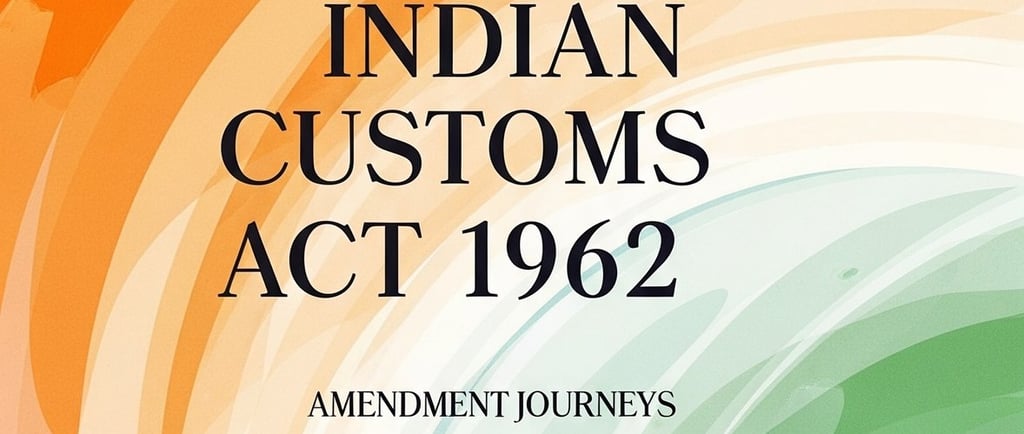Evolution of the Customs Act, 1962: A Year-Wise Journey of Key Amendments
The Customs Act, 1962 is a cornerstone of India’s trade and taxation framework, governing the levy of duties on imports and exports. Since its enactment, the Act has undergone numerous amendments to align with economic reforms, global trade standards, and technological advancements. Below, we trace the significant amendments year by year, highlighting the topic and a concise overview of each update, from the earliest notable changes to the latest in 2025.
INTERNATIONAL TRADEIMPORTSINDIAN CUSTOMSCUSTOMS DUTY
6/24/20253 min read


1985: Strengthening Anti-Smuggling Provisions
Topic: Enhancement of enforcement measures
Overview: The Customs (Amendment) Act, 1985, bolstered the Act’s provisions to combat smuggling and protect economic interests. It introduced stricter penalties, enhanced powers for customs officers to conduct searches and seizures, and clarified procedures for confiscation of goods. These changes aimed to curb illegal trade and strengthen border control mechanisms.
1995: Simplification of Duty Structures
Topic: Rationalization of customs duties
Overview: The Finance Act, 1995, amended the Customs Act to streamline duty structures as part of India’s economic liberalization. It reduced tariff rates, simplified classification of goods, and introduced measures to facilitate trade while maintaining revenue collection. This marked a shift toward aligning customs policies with global trade practices.
2006: Introduction of Risk Management Systems
Topic: Modernization of customs processes
Overview: Amendments via the Finance Act, 2006, introduced the Risk Management System (RMS) to modernize customs clearance. This allowed for selective scrutiny of shipments based on risk profiles, reducing delays and enhancing efficiency. The changes supported faster trade processing while ensuring compliance with customs regulations.
2011: Advance Ruling and Settlement Commission Enhancements
Topic: Dispute resolution and clarity
Overview: The Finance Act, 2011, strengthened the Advance Ruling mechanism under the Act, enabling importers and exporters to seek clarity on duty liabilities before transactions. It also expanded the scope of the Customs Settlement Commission to resolve disputes amicably, reducing litigation and fostering trust in the customs framework.
2018: E-Way Bill Integration and Digital Compliance
Topic: Digitalization of customs processes
Overview: Amendments in 2018, aligned with GST reforms, integrated electronic processes like the e-way bill system into customs operations. The changes, introduced via the Finance Act, 2018, mandated electronic filing for bills of entry and shipping bills, enhancing transparency and reducing paperwork. This marked a significant step toward a paperless customs ecosystem.
2019: Trade Facilitation and Simplified Assessments
Topic: Ease of doing business
Overview: The Finance Act, 2019, introduced amendments to promote trade facilitation under the World Trade Organization’s Trade Facilitation Agreement (TFA). Key changes included simplified assessment procedures, faster clearance for compliant traders, and provisions for Authorized Economic Operators (AEOs) to streamline customs processes for trusted entities.
2023: Customs Duty Exemptions and Make in India Support
Topic: Duty exemptions and domestic manufacturing
Overview: The Finance Act, 2023, amended the Customs Act to introduce exemptions and concessions on customs duties for specific goods to boost domestic manufacturing under the "Make in India" initiative. It also refined provisions for anti-dumping duties and countervailing duties to protect local industries from unfair trade practices.
2024: Streamlined Procedures and Digital Enhancements
Topic: Procedural efficiency and digital compliance
Overview: The Finance (No. 2) Act, 2024, part of the Union Budget 2024-25, focused on streamlining customs procedures. It introduced further digitalization of clearance processes, clarified provisions for provisional assessments, and enhanced mechanisms for trade compliance. These changes aimed to reduce delays and improve transparency in customs operations.
2025: Major Reforms for Trade Facilitation
Topic: Provisional assessments, voluntary revisions, and institutional changes
Overview: The Finance Bill, 2025, introduced transformative amendments to the Customs Act, 1962:
Provisional Assessment Timeline: A new 2-year limit (extendable by 1 year) for finalizing provisional assessments under Section 18, ensuring faster resolution.
Voluntary Entry Revision: Added Section 18A, allowing importers/exporters to voluntarily revise customs entries, enhancing flexibility and compliance.
Abolition of Settlement Commission: Eliminated the Customs Settlement Commission to streamline dispute resolution and reduce redundant mechanisms.
Digital Compliance: Strengthened electronic processes for faster clearances, aligning with global trade standards and improving transparency.
Export Entry Regulations: Replaced the 2022 Export Entry (Post-Export Conversion) Regulations with new rules under Section 149 to simplify post-export processes.
These amendments reflect India’s commitment to modernizing customs administration, promoting ease of doing business, and supporting digital trade infrastructure.
Looking Ahead
The Customs Act, 1962, has evolved significantly since its inception, adapting to India’s economic growth, technological advancements, and global trade commitments. From anti-smuggling measures in the 1980s to digital reforms and trade facilitation in 2025, each amendment has shaped a more efficient and transparent customs framework. For the latest updates, keep an eye on the Union Budget 2025-26 (expected February 2025) on www.indiabudget.gov.in, and refer to primary sources like the CBIC website (www.cbic.gov.in) (www.cbic.gov.in) or India Code Portal (www.indiacode.nic.in) (www.indiacode.nic.in) for precise legal texts. For complex implications, consulting legal or customs experts is advisable to navigate the evolving landscape effectively.
Note: This blog provides a high-level overview based on available information. Comprehensive details of every amendment may require accessing official gazettes or legal databases, as the Act has been amended frequently through Finance Acts and notifications.

Astan Finserv Consultancy Services
Export Consultation, Export and Customs Documentation, Duty drawback and Indian Govt Export Schemes and Export Trainings.
© 2025. All rights reserved.